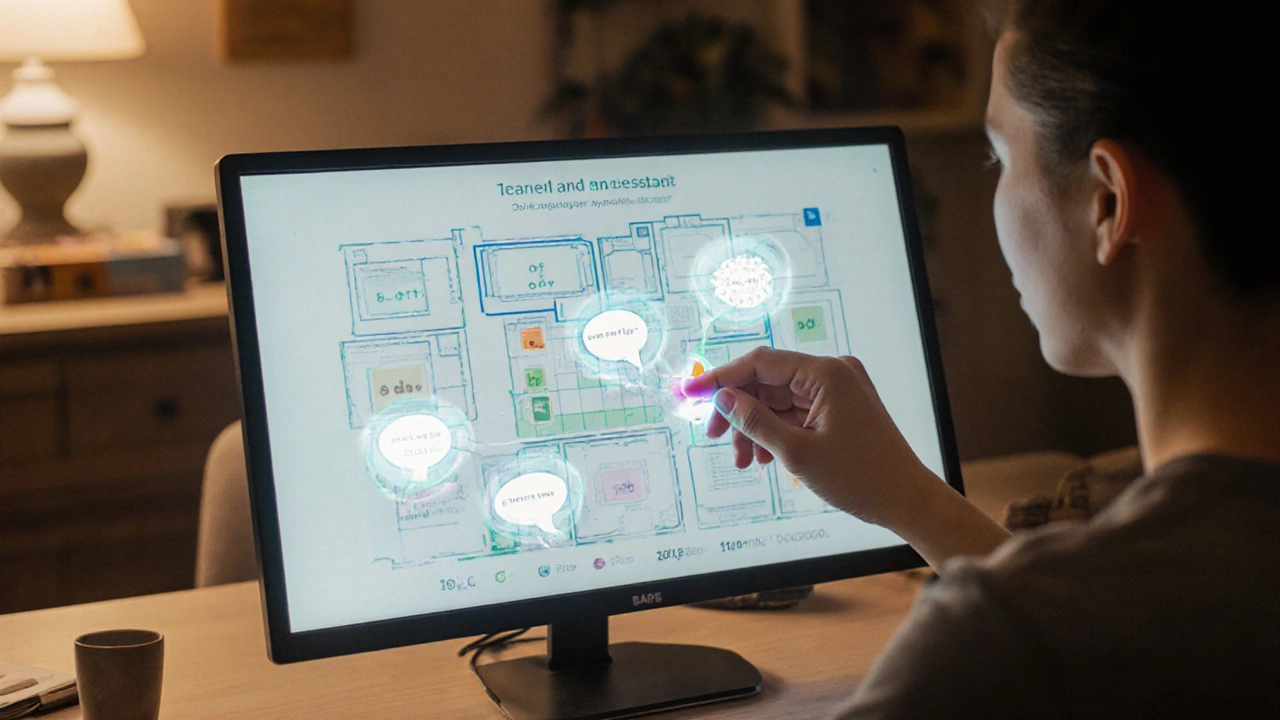Branching Scenario Simulator
Customer Service Scenario
A customer is frustrated with a delayed order. They've been on hold for 25 minutes and are demanding a manager.
Select an option to see the outcome
Your choice will determine the customer's experience and the outcome of this situation.
Most online courses fail before learners even finish the first module. Why? Because they’re just slides with audio. No interaction. No feedback. No reason to come back. If you’re trying to create an interactive eLearning course, you’re not just building content-you’re building an experience. And that changes everything.
Start with the learner’s brain, not the screen
People don’t learn by watching. They learn by doing. A 2024 study from the University of Melbourne found that learners who engaged in active recall and scenario-based choices retained 68% more information than those who only watched videos. That’s not a small edge-it’s the difference between a course that gets ignored and one that gets shared.
So stop thinking about how to fit more content on a page. Start thinking: What will the learner do right now? Will they drag and drop labels onto a diagram? Will they choose how a customer service call goes? Will they solve a real-world problem before seeing the answer?
Every screen should have a purpose beyond showing information. It should demand a decision, a click, a reflection, or a response. If your module doesn’t require the learner to do something, it’s not interactive. It’s just a video with buttons.
Build choices that matter
Interactive doesn’t mean flashy animations or pop-up quizzes. It means consequences. When a learner picks an option, they should feel like it actually changed something.
For example, in a compliance training course for retail staff, instead of asking, “What’s the correct procedure for handling a suspicious person?”-give them a video of a real situation. Let them choose:
- Approach and ask questions
- Call security immediately
- Ignore and continue stocking shelves
Then show them what happens next based on their choice. If they ignore the person, the store gets robbed. If they call security, the situation de-escalates safely. Suddenly, the lesson sticks because it felt real.
This is called branching scenarios. And they work because they mimic how people learn in real life-through trial, error, and feedback. You don’t need fancy tools to build them. Even simple tools like Articulate Storyline or Google Slides with hyperlinks can do the job.
Use feedback that teaches, not just corrects
Bad feedback says: “Wrong.”
Good feedback says: “You chose to ignore the warning sign. That’s what happened in the 2023 incident at Sydney’s Westfield Mall-three employees were injured because no one reported the leak. What would you do differently next time?”
Feedback is your most powerful teaching tool. Don’t just tell learners they’re right or wrong. Explain why. Show them the real-world impact. Tie it to data, stories, or consequences they can relate to.
And don’t wait until the end of a module to give feedback. Give it after every meaningful choice. That’s how you keep learners hooked. It’s like a video game-you get immediate results for your actions. That’s why people play for hours.

Break content into micro-interactions
Long lectures kill engagement. Even if they’re only 10 minutes long. The human brain tunes out after 6-8 minutes without stimulation.
So break every module into 5-7 minute chunks. Each chunk should have:
- A short video or animation (under 90 seconds)
- A quick drag-and-drop or matching activity
- A multiple-choice question with immediate feedback
- A reflection prompt: “Have you seen this happen at work?”
For example, in a course on financial literacy:
- Video: “What happens when you only pay the minimum on your credit card?”
- Activity: Drag monthly payments to see how long it takes to pay off $5,000 at 18% interest
- Question: Which option saves you the most money over 2 years?
- Reflection: “What’s one expense you could cut to pay more toward debt?”
Each piece is small. But together, they create momentum. Learners feel progress. They don’t feel overwhelmed.
Let learners explore, not just follow
One of the biggest mistakes in eLearning is forcing everyone down the same path. Real learning isn’t linear. People have different backgrounds, questions, and speeds.
Build optional paths. Add “Deep Dive” sections for those who want more. Add “Quick Review” boxes for those who need a reminder. Let them skip ahead if they pass a quick check. Give them control.
At a hospital in Adelaide, nurses used an interactive eLearning module for infection control. They could choose to explore handwashing techniques, PPE use, or waste disposal-based on their role. Nurses in the ER focused on gloves and masks. Kitchen staff focused on sanitizing surfaces. The completion rate jumped from 42% to 89% in three months.
When learners feel the course is made for them, not just at them, they show up.
Use real data, real stories
Generic examples don’t stick. “A company lost money because of poor communication” is forgettable.
“In 2024, a logistics company in Brisbane lost $1.2 million because a driver didn’t see the warning about a blocked road-because the alert was buried in a 20-page PDF” is unforgettable.
Use real incidents. Use real names (with permission). Use real numbers. Learners don’t care about theory. They care about what happens next.
Even better-let learners submit their own stories. Add a simple text box: “Have you faced something like this? Share your experience.” Then, with permission, turn those into new case studies. Now your course grows with your learners.

Test it like a product, not a presentation
Don’t launch your course and hope for the best. Test it with real users before you roll it out.
Grab five people who match your target audience. Give them 15 minutes with your course. Watch what they click. Watch where they pause. Watch where they get frustrated.
Here’s what to look for:
- Do they skip the videos?
- Do they guess on quizzes without reading?
- Do they click the same button three times because it’s not clear?
Fix those things before you spend money on hosting or training. A course that confuses learners is worse than no course at all.
Tools you can start with today
You don’t need a $20,000 LMS to build something powerful. Here’s what works right now:
- Canva + Canva Presentations - For drag-and-drop visuals and simple branching
- Google Slides - Use hyperlinks to create branching paths (yes, really)
- Articulate Rise - Built for quick, mobile-friendly interactive courses
- H5P - Free, open-source tool for quizzes, interactive videos, and timelines
- Kahoot! or Quizizz - For live or self-paced gamified quizzes
Start small. Build one interactive module. Test it. Then build another. You’ll learn more from five real users than from ten training webinars.
Interactive eLearning isn’t about tech-it’s about trust
The most powerful interactive element isn’t a drag-and-drop or a quiz. It’s the feeling that someone built this course for you-not for the company, not for compliance, but for you.
When learners feel seen, they engage. When they feel like their choices matter, they remember. When they feel like the content speaks their language, they come back.
So stop chasing the fanciest platform. Start asking: What does my learner need to do today? What will make them pause and think? What will make them say, ‘I didn’t know that would happen’?”
That’s how you create an interactive eLearning course that doesn’t just get completed-it gets remembered.
What’s the difference between interactive eLearning and a regular online course?
A regular online course delivers information-videos, PDFs, slides. Interactive eLearning requires the learner to act: make choices, solve problems, respond to feedback. It’s not about watching-it’s about doing. That active participation boosts retention by up to 70% compared to passive learning.
Do I need expensive software to build interactive eLearning?
No. You can start with free or low-cost tools like Canva, Google Slides, or H5P. Many organizations build powerful interactive modules using just these. What matters isn’t the tool-it’s the design. A well-thought-out branching scenario in Google Slides beats a flashy but empty course in Articulate 360 every time.
How long should an interactive eLearning module be?
Keep each module under 10 minutes. Break longer topics into 5-7 minute chunks, each with one clear interaction: a decision, a quiz, a drag-and-drop, or a reflection prompt. The brain loses focus after 6-8 minutes without engagement. Short, focused, and interactive beats long and boring.
Can interactive eLearning work for compliance training?
Yes-and it’s essential. Compliance training fails when it’s just a checkbox. Interactive scenarios show real consequences: What happens if you skip a safety step? What if you ignore a harassment report? Real-life branching stories make rules stick. A 2024 study showed companies using interactive compliance modules had 54% fewer incidents than those using traditional PDFs.
How do I measure if my interactive course is working?
Track more than completion rates. Look at: How many learners retry failed interactions? How many spend extra time in “Deep Dive” sections? How many return to rewatch a scenario? Are they submitting real-life examples? High engagement and repeated use mean the course is working-not just being clicked through.
If you’re building an interactive eLearning course, start small. Build one module. Test it with real people. Listen to what they say. Then build the next one better. That’s how you create learning that lasts.
